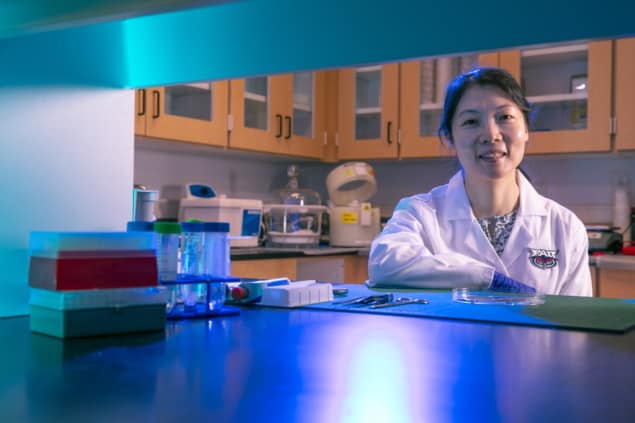
Researchers in the US have developed a “placenta-on-a-chip” that closely mimics the molecular exchange of nutrients between mother and foetus during pregnancy. Sarah Du and colleagues at Florida Atlantic University created the device using a pair of microfluidic channels, separated by an intricate network of hydrated fibres cultured on each side with different placental cells. The setup enabled the team to recreate disruptions to nutrient exchange caused by placental malaria, and could be a key step towards developing a treatment for the disease.
The placenta is an organ that develops alongside a foetus during pregnancy. It plays a vital role in mediating the exchange of nutrients, oxygen and waste products between a mother and her developing foetus. Among the most pressing threats to this exchange is placental malaria: a disease caused by a parasitic, single-celled organism named Plasmodium falciparum, which infects the mother’s red blood cells. By disrupting the supply of nutrients to the foetus, this disease can result in severely diminished birth weight – ultimately causing up to 200,000 newborn deaths, as well as 10,000 maternal deaths each year.
The placenta’s structure is intricately complex: featuring multi-layered structures made up of many different types of cell, as well as branching blood vessels named “villous trees” where the molecular exchanges between maternal and foetal blood take place. These structures can trap parasite-infected red blood cells, restricting the flow of nutrients between mother and foetus.
These complex structures are exceptionally challenging to reproduce using models; but ethical constraints also mean that infected placentas can’t simply be examined during pregnancy. As a result, treatments for this disease have so far proven particularly difficult to develop. To address this challenge, Du’s team developed the novel placenta-on-a-chip.
The device is centred around an extracellular matrix gel containing a hydrated network of tough collagen fibres that allow molecular nutrients to pass through. The researchers cultured one side of the gel with a sample of the trophoblast cells found on the outer layer of the placenta, which directly interact with the mother’s blood. On the other side, they developed a culture of the cells that line the inside of the human umbilical vein, which interact with the foetus’ blood.

Correcting an historical failure in women’s health
This gel was then used to separate a pair of co-flowing microfluidic channels – representing the blood of a mother and her foetus. Using this simplified setup, Du and colleagues infected blood in the channel facing the trophoblast cells with Plasmodium falciparum and observed how the infected blood cells adhered to the surface, using a specific molecule expressed by the placental cells. Subsequently, they observed a diminished transfer of glucose across the gel barrier: reproducing a key feature of placental malaria.
This successful result shows that the placenta-on-a-chip could become a vital resource for studying placental malaria, and possibly even other types of placenta-related diseases. By offering a clear view of how the disease unfolds, Du’s team hope that their device could eventually lead to novel treatments, which may ultimately save thousands of lives globally each year.
The researchers report their findings in Scientific Reports.



